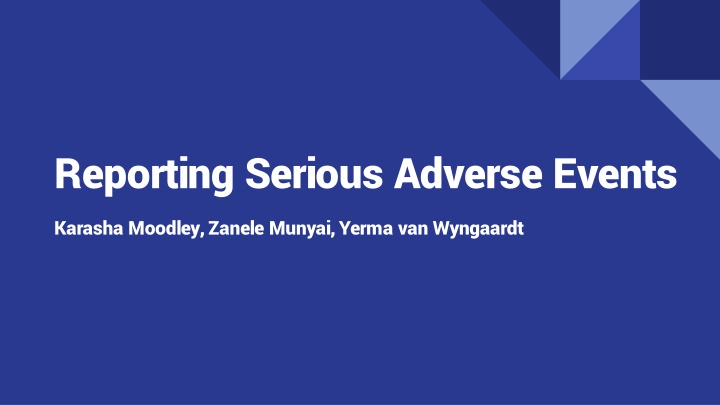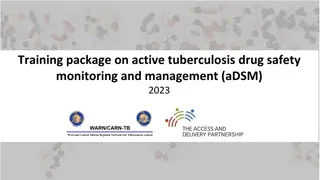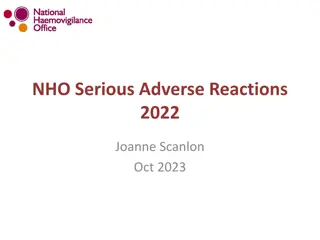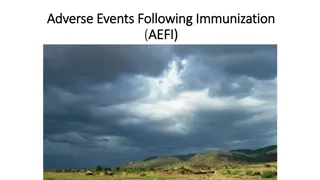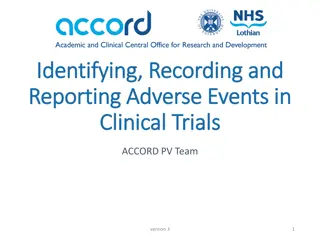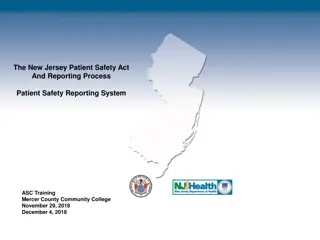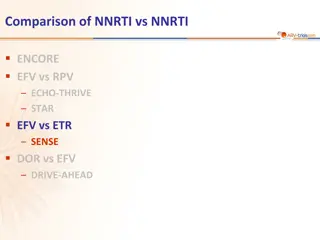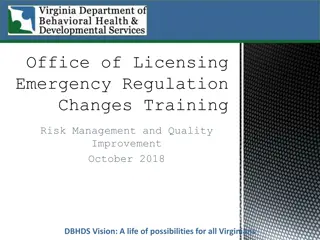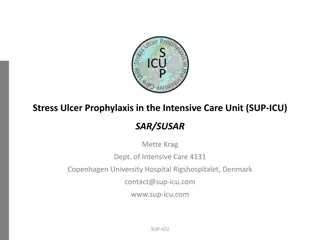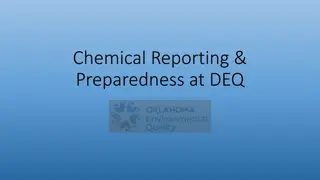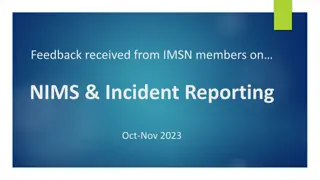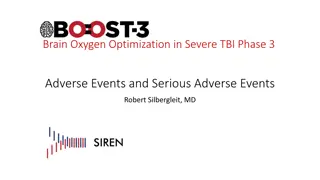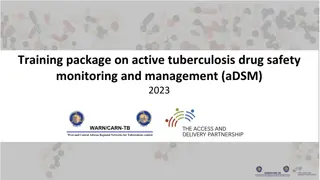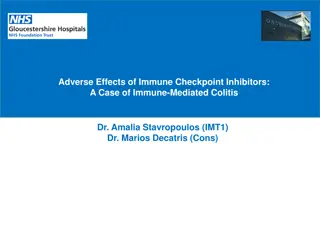Reporting Serious Adverse Events and Management Protocols
Define, identify, and manage serious adverse events in healthcare settings. Explore the characteristics, examples, and severity assessment codes to ensure proper handling of adverse reactions and events.
Download Presentation

Please find below an Image/Link to download the presentation.
The content on the website is provided AS IS for your information and personal use only. It may not be sold, licensed, or shared on other websites without obtaining consent from the author.If you encounter any issues during the download, it is possible that the publisher has removed the file from their server.
You are allowed to download the files provided on this website for personal or commercial use, subject to the condition that they are used lawfully. All files are the property of their respective owners.
The content on the website is provided AS IS for your information and personal use only. It may not be sold, licensed, or shared on other websites without obtaining consent from the author.
E N D
Presentation Transcript
Reporting Serious Adverse Events Karasha Moodley, Zanele Munyai, Yerma van Wyngaardt
Introduction: NDOH mission: improve health status by prevention of ill health. Health Charter: right to complain, complaints investigated, response to the complaint.
Definitions Adverse event: any untoward medical occurrence that may present during treatment with a medicine/intervention but which does not necessarily have a causal relationship with this treatment. Adverse reaction: a response to a medicine/intervention which is noxious and unintended. Unexpected adverse reaction: one in which the nature, specificity, severity and outcome is not consistent with the applicable product information.
Serious adverse event any unexpected medical occurrence that Results in death Is life threatening Requires patient hospitalization or prolongation of existing hospitalization Results in persistent or significant disability/incapacity or A congenital anomaly/birth defect
Characteristics of an adverse event: 1.Negativity 2.Patient involvement/impact 3. Causation NB! Not all adverse events are preventable. Eg. an allergic reaction to a drug where patient had no allergies.
Examples of Adverse Events Drug reaction Transfusion reaction Wrong site surgery Restraint related injuries Pressure ulcers Mistaken patient identities Procedure related
How to manage an adverse reaction 1. Identify incident 2. Action 3. Prioritisation = Severity Assessment Code 4. Notification PSI form Register Time frame (based on S.A.C) Notify patient
Severity Assessment Code Used to prioritise adverse event and is based on the degree of harm suffered. It determines the level of investigation required. 1. Serious harm/death = report to district/provincial within 24 hours 2. Moderate harm = report to executive management of the facility 3. Minor or no harm = report to executive management of the facility
(South African Department of Health, 2017)
How to manage an adverse reaction cont 5. Investigation and report of investigation 6. Classification 7. Analysis 8. Implementation of recommendations 9. Learning
(South African Department of Health, 2017)
(South African Department of Health, 2017)
(South African Department of Health, 2017)
What to include when reporting an adverse event Patient details (name,surname, patient file number, gender, age) Date and time of incident occurring Location (name of facility, as well as which area of facility) Agent(s) involved: either the procedure, medication, person involved Type of incident Incident outcomes Resulting actions Reporter (can be anonymous): name, surname, designation. Agent, type of incident and incident outcomes use the WHO framework for the International Classification for patient safety Remember to fill out additional forms if applicable (e.g blood transfusion reaction, drug reaction)
(South African Department of Health, 2017)
(South African Department of Health, 2017)
(South African Department of Health, 2017)
Clinical Risk Management Team Every health care facility is required to have one. CEO Nursing manager Medical manager Systems manager Find out who is apart of your clinical risk management team!
Conclusion: It is a passive monitoring system Identify clinical risk management team It is your responsibility to report adverse events WHO PSI DATA
References South African Department of Health, 2017. National Guideline for Patient Safety Incident Reporting and Learning in the Public Health Sector of South Africa. Pretoria: NDoh, pp.8-62. University of Kwazulu-natal, n.d. Adverse Events Monitoring and Reporting Guidelines. Durban: Nelson Mandela School of Medicine, pp.3-9. Semete, B., 2020. Guidelines for Adverse Drug Reactions Reporting for Healthcare Professionals. [ebook] Pretoria: South African Health Products regulatory authority, pp.5-9. Available at: <http://www.sahpra.org.za> [Accessed 19 February 2021].
Case 1 You are the doctor on call in ED. A 50 year old male comes in complaining about a 1 month history of increased frequency, urgency and dribbling that is getting worse over the past week and 1 day history of difficulty urinating. It is 1am and you consult the urologist from another hospital who asks you to put in a Transurethral catheter and he will come see the patient later. The patient is uncircumcised, you therefore retract the foreskin and insert the catheter. As you blow up the balloon the resus bell rings, you tell the patient to please cover up and you will come back. 4 hours later while you are writing notes for the resus patient, the nurses call you as the urology patient is screaming in pain. His penis became erythematous, the glans and foreskin are swollen.You realise you did not reposition the foreskin after inserting the catheter and he now developed a Paraphimosis. 1. What will you say to the patient? 2. Grade the severity of the adverse event in this case scenario?
Case 2 You are working in Polyclinic at a small hospital in Mpumalanga. A 25 year old female presents to you with signs and symptoms of VDS. She reports no known allergies. You prescribe Antibiotics and ask the nurse to please administer the Ceftriaxone IM before she goes to get the other medication. 5 minutes later you are called to the treatment room as the patient became tachycardic, started developing generalised body itching, hives and swelling of the eyes while you were there. You administered emergency steroids and epinephrine 1. Who do you report this adverse event to and in what time period? 2. What will you include in reporting the event?
Case 3 A 34 year old male presents at your local clinic with a two day history of a severe headache, nausea, and a stiff painful neck. After your examination, you list meningitis as one of your differentials. There is no CT Scan in your clinic and the closest tertiary hospital is 30 KM away. Phone lines are currently down. You present your case to the MO on cover with you, who advises you to perform a Lumbar Puncture. Minutes later, as you were dropping the samples at the lab, a sister calls frantic. The patient you had just performed the procedure on has changed conditions . The patient had elevated blood pressures, bradycardia, decreased level of consciousness, seizures and loss of deep tendon reflexes. The patient was intubated using RSI, hyerventilated and given an osmotic diuretic, while an ambulance is being organised for hospital. 1. 2. How would you classify this incident? The patient fully recovers and is discharegd from the hospital. A month later that patient arrives with his lawyer and says he is going to sue for what happened to him.Discuss the idea of informed consent regarding procedures that we as health care workers routinely do and do not always get consent for.
